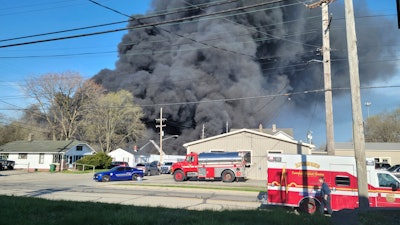
A fire at a scrap plastics business in Indiana raises numerous health concerns for people in the area — particularly with the discovery of asbestos in debris, experts said Friday.
An evacuation order for about 1,500 residents of the town of Richmond near the Ohio line remained in effect as firefighters doused hot spots while federal, state and local agencies monitored air and water for contamination. It might take weeks for the fire to be fully extinguished, officials said.
Plans are being developed to deal with asbestos fragments in nearby neighborhoods, the U.S. Environmental Protection Agency said. Inhaling asbestos can cause lung diseases, including cancer.
"Probably the worst thing you can do if you have debris in your yard would be to mow and break up that material" and possibly inhale it, EPA on-scene coordinator Jason Sewell said.
Crews were taking air measurements at 34 sites, he said, with some samples being sent for laboratory analysis. Monitors in the evacuation zone detected hydrogen cyanide, benzene, chlorine, carbon monoxide and volatile organic compounds. Also spotted was particulate matter, or soot, which is common with fires.
 Firefighters walk out of the site of an industrial fire in Richmond, Ind., Wednesday, April 12, 2023.AP Photo/Michael Conroy
Firefighters walk out of the site of an industrial fire in Richmond, Ind., Wednesday, April 12, 2023.AP Photo/Michael Conroy
WHAT IS ASBESTOS, AND WHY IS IT DANGEROUS?
Asbestos is a group of naturally occurring mineral fibers in many soils and rocks. Because of its strength and resistance to heat, chemicals and corrosion, it was used widely in building construction. Floor and ceiling tiles, insulation, pipes, adhesives and boilers were among products made with asbestos.
Although not inherently toxic, asbestos fibers that people breathe in can stick to lungs and irritate the tissues. Prolonged inhalation causes scarring that can lead to breathing problems.
In some cases, asbestos can cause a variety of cancers including mesothelioma, a rare form that affects membranes lining internal organs. It can take decades after exposure to appear, according to the U.S. Centers for Disease Control and Prevention.
IS IT STILL USED?
In 1989, EPA banned manufacture, import, processing and distribution of some products with asbestos and outlawed new uses. Asbestos mining in the U.S. stopped in 2002, although some is imported and still used in construction.
Many homes and other buildings have materials, particularly insulation, with asbestos.
HOW MIGHT THE RICHMOND FIRE HAVE SPREAD ASBESTOS AND OTHER CONTAMINANTS?
Any significant disturbance, such as a structural failure, can release microscopic asbestos fibers, said Neil Donahue, a Carnegie Mellon University chemistry professor.
"If you had a wall that collapsed, dust gets generated and a fire plume is the perfect place to take that dust and lift it up and disperse it," he said.
EPA collected two samples of "bulk debris" that blew away and were found roughly 1.5 miles from the fire site, Sewell said. One tested positive for asbestos.
Smoke from virtually any fire will spread particulate matter, which can drift for miles and stay in the air until rain carries it to the ground.
WHAT POLLUTANTS DO PLASTIC FIRES GENERATE?
Volatile organic compounds — human-made chemicals used in thousands of products, from paints and drugs to cleaning supplies and office equipment.
They can cause eye, nose and throat irritation, breathing difficulty and nausea. Heavy exposure causes nervous system and organ damage, while some are linked to cancer.
Burning plastic also can release hydrochloric acid, sulfur dioxide, carbon monoxide and heavy metals.
Another potential danger comes from dioxins, which experts say can be generated when vinyl chloride — the chemical used to make rigid PVC pipes — is burned. EPA ordered testing for the highly toxic compounds after a Feb. 3 train derailment in East Palestine, Ohio, that caused vinyl chloride releases.
"They're incredibly long-lived, not floating in the air as much as stuck in the soil," said John Anderson, a University of Chicago chemistry professor. "Those are the things people nearby should be worried about for long-term exposure. Smoke, air pollution, tends to be transient. It moves and disperses."
Dioxins enter human bodies primarily through consumption of tainted meat or other foods.
WHAT CAN LOCAL RESIDENTS DO TO PROTECT THEMSELVES?
While smoke remains visible, avoid the area as much as possible and consider wearing an N95 mask — a type used widely during the COVID-19 pandemic, Anderson said.
Inhaling asbestos over a few days should cause little lung scarring, he said. "But if you're there for weeks and being exposed to this, it can be a real problem."
Typically the people who are highly exposed to asbestos are those who mine it or work with it, such as construction laborers, Anderson said.
Residents should stay informed about testing by government agencies, Donahue said. Air, groundwater and soil are pathways for contaminants to reach human bodies.
"Who's thinking about the various places that toxic residue from this event might wind up? I would want to know who's doing that, and how can I confirm and verify what they're finding," Donahue said. "What concentrations are they worrying about and why, and what they're actually seeing."





















